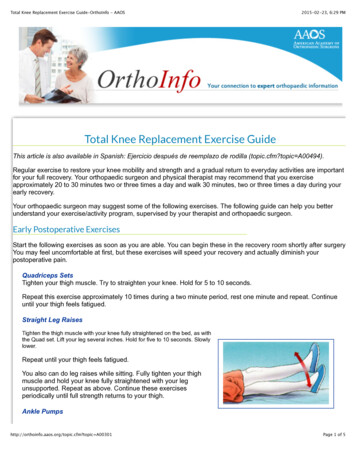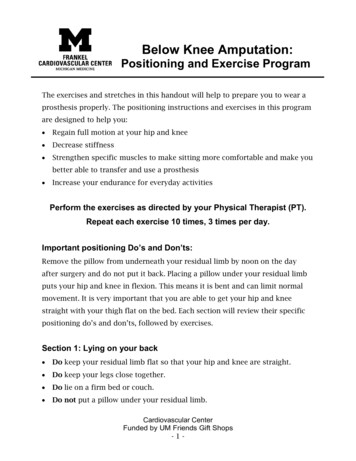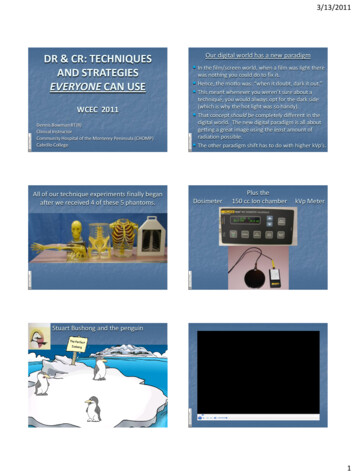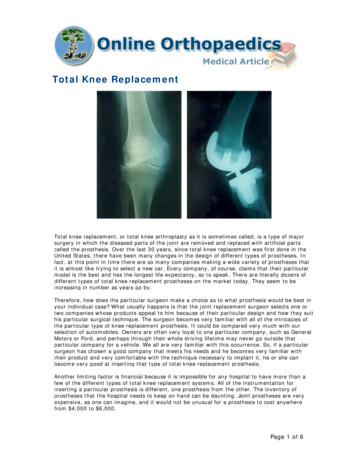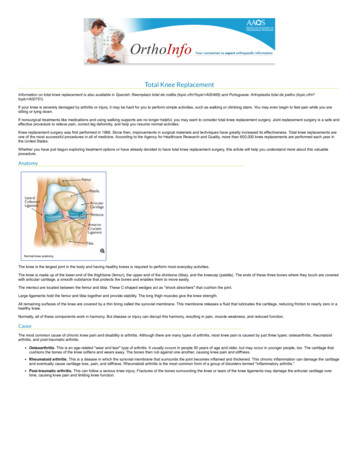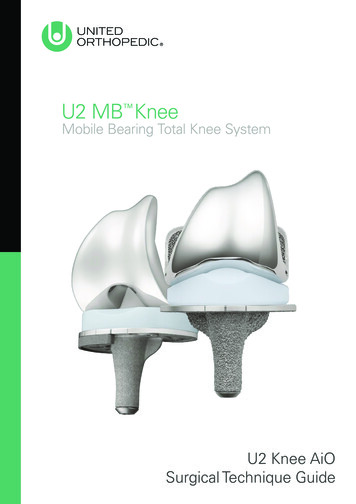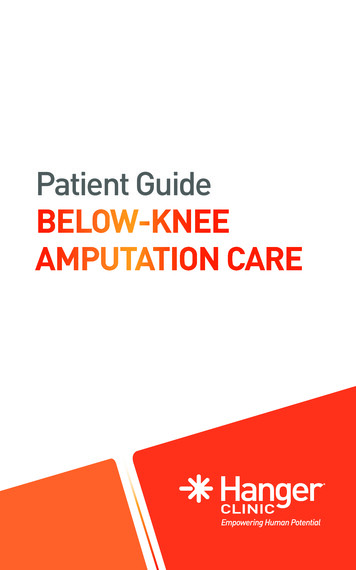
Transcription
Patient GuideBELOW-KNEEAMPUTATION CARE
TABLE OF CONTENTSWHERE TO BEGIN.1Who will provide my prosthetic care?.2What will my insurance cover?.3How long does rehabilitation take?.4What is going to happen next?.6RECOVERY AND HEALING.7How wilI I recover physically?.7How to keep your limb healthy.8How will I heal emotionally?.9INITIAL MOBILITY.10What happens at my first prosthetic evaluation?.10What are the parts of a prosthetic leg?.11How is the prosthesis held to my limb?.12How will I learn to use my prosthesis?.13LIFELONG CARE.14How do I care for my limb?.14Common limb problems.15How do I care for my prosthesis?.16What shoes can I wear?.17What home aids and modifications will I need?.17When will I get a replacement?.18What’s next?.19
WHERE TO BEGINWhat do you do when an injury turns your life upside down anddoctors say you’ll never walk again? Find someone who believes,like you, that your potential is unlimited. After Cameron Clapp lostboth legs and an arm in a train accident, he surrounded himselfwith people who supported his vision of a future that includedwalking, surfing and motivating others. The people at Hanger Clinichave been behind him every step of the way.“Impossible is not afact; it’s an opinion.”– Cameron ClappLosing your limb can be overwhelming, but you are not facingthis challenge alone. Many people will help you adjust to youramputation and return to a healthy, active lifestyle. This includesyour team of healthcare professionals, such as your physician,prosthetist, physical therapist, nurse and occupational therapist.YOUR PROSTHETIST:LOCATION:PHONE NUMBER:1
Who will provide my prosthetic care?As you begin your rehabilitation, you will work with a prosthetistwho is trained in the design, fabrication and fitting of artificial limbs(prostheses). Your prosthetist has skills and experience that willempower you to achieve your goals. It is important to talk to yourprosthetist about your desires, expectations and concerns so that heor she can best address your needs. You will continue to partner withyour prosthetist for routine maintenance, expected adjustments andfuture prosthetic care.Hanger Clinic prosthetists are board certified. A certified prosthetisthas successfully completed years of specialized training and passeda thorough examination administered by the American Board forCertification in Orthotics and Prosthetics (ABC) or the Board ofCertification (BOC).Your prosthetist will work closely with your physician, who willmonitor your health, and your physical therapist, who will teach youhow to use your prosthesis.2
What will my insurance cover?The cost of a prosthetic leg includes the specialized serviceswe provide. Your prosthesis is a custom-made device that takestime and skill to design and fit. The cost of your device can varygreatly depending on the design that is medically necessary foryou. Fees may be charged for modifications and adjustmentsthat are necessary as your limb changes shape and size, butmost initial adjustments and follow-up appointments areprovided at no charge. Please contact your prosthetist with anyfinancial concerns.Prosthetic care is covered under most health insurance plansonce deductibles and copayments are met. Our staff will helpyou understand your coverage and coordinate with your insurer.Please let our office know about any changes in your insurance.In addition, there are government funded programs available forpeople with physical challenges which may provide additionalsupport.IMPORTANT THINGS TO REMEMBER:Hanger Clinic generally requires a physician’s prescriptionfor all prosthetic services, supplies and devices; especiallyif we are billing an insurance company.Insurance approval for new supplies or devices may taketime. Do not wait until the last minute.Our team of prosthetists and office administrators wantthe best results for you. Please be patient as we partnerwith your physician’s office and your insurance companyto get approval for your supplies. Feel free to follow upwith us about the status of your claim.3
How long does rehabilitation take?This is a general rehabilitation timeline for lower limb amputation.You may not experience all of these steps in exactly these timeframesbecause everyone’s experience is unique. Talk to your prosthetist if youhave questions about the expectations for your individual IROAIOLVCEAMEIHRYLVITERICAIONTIGPENRIVNERYST-O NEGACILPOPOHITA-LOHINEGAL REPOSPRE-OPEYPROHTESVOOPCPRE-OPYRVEYRPP ORRCOEVPRET-OC-ORE Incision healed-OOPSSTPST-POOP Post-op protectoror dressing applied Arrange peer visit Begin limb shapingand pre-prosthetictraining43-4WEEKS5-8WEEKS Suture removal Evaluation forfirst prosthesis Measurements,casting and/orscanning forprosthesis
LLFEGOINRELLAENER CLTIFIORE CA GORNACANGELONIUTGO Receive definitiveRNAMIOON ELLIFYAATTUEL LIFTRMprosthesisIFUILL IONBAITTMYMIOTLNLIAOAI BYTTI R INORNA Follow-up careLIOTLIIMATU TIOABAATTIUMRIM Limb volumeNUGILT IMNYIAALITEA ITMYBIL Hstabilization Maintenance andLING INAEGNreplacements Fit initialprosthesis Ongoing therapyand prostheticadjustments Begin prostheticgait trainingIndividual experiences will vary.5
What is going to happen next?POST-OP LIMB CAREYour doctor may prescribe a shrinker to help shape yourresidual limb and/or an AmpuShield to protect your leg frominjury (see page 8).FIRST PROSTHETIST MEETINGYour prosthetist will get to know you and ask about your dailyactivities. He/she will listen to your goals and then use his/herclinical expertise to design the right prosthesis for you.INITIAL PROSTHESISWhen your residual limb is sufficiently healed, you will bemeasured and fit with a prosthesis. The prosthesis you takehome will be custom made using materials most appropriatefor your needs. Your prosthetist will teach you how to put onand care for your prosthesis and supplies, as well as how totake care of your limb.PHYSICAL THERAPYYour physician, prosthetist and/or physical therapist willteach you how to use your prosthesis. You may be able toresume physical activities such as walking up and down stairs,driving and participating in sports and hobbies once you havemastered these skills.FOLLOW-UP CAREYour prosthetist will continue to make adjustments, fittingsand replacements as necessary. It is important to follow upwith your prosthetist at least every six months to address anyissues, especially as your residual limb is changing in size.6
RECOVERY AND HEALINGHow will I recover physically?Some people are slow to heal after amputation due to other healthcomplications, which may delay prosthetic fitting. Be patient andremember that your goal is long-term success.After amputation surgery, it is very important toprotect your residual limb and to prevent falls.Falls can cause your sutures (stitches) to reopen,which delays the healing process. Removablerigid dressings such as AmpuShield are provento protect your limb, speed the healing processand shorten the time to prosthetic fitting.Another post-operative dressing option is ashrinker or compression sock. The shrinkerwill prepare your limb’s volume and shape fora future prosthesis.AmpuShield ShrinkerIf you see sores or blisters on your limb and/or near your sutureline, you should speak to your doctor. Your doctor or physicaltherapist may suggest exercises you can do while healing.7
HOW TO KEEP YOUR LIMB HEALTHYExercising is important preparation for gait training. Your prosthetistand/or physical therapist will teach you specific exercises and giveyou an exercise schedule.You can also perform easy tasks at home: Keep knee straight while sitting in wheelchair or on the bed Stretch your limb daily Wear your shrinker or compression sock according to yourdoctor’s instructions Massage and desensitize your limb according to your doctor’sinstructions Safely practice transferring from chair to bed (toileting, bathing, etc.) Safely practice balancing on one leg on a stable surface with yourassistive deviceEXERCISE EXAMPLESHome exercises are provided by the Amputee Coalition rcisesTo prevent muscle tightening, DO NOT:Keep leg in a bent position while in bed or sittingCross your knees while sittingPlace pillow under hip or knee8
How will I heal emotionally?Losing any part of your body can be traumatic and lifechanging. Everyone has their own way of coping, and itis OK to grieve. Counseling and support groups can helpyou process the many emotions you may experienceafter amputation. Speak to your doctor if you’re feelingoverwhelmed.Family members and friends may be a source ofencouragement and support even if they do not fullyunderstand what you are going through.Other people living with amputation can also provide inspirationand information. Our AMPOWER support program has 1,000certified peer visitors who understand what you’re going throughfrom personal experience and can meet with you in-person, byphone or online. You can also ask your prosthetist who he or shewould recommend.CONTACT THE AMPOWER TEAMCall 1-844-AMPOWER (1-844-267-6937), visitHangerClinic.com/AMPOWER and join EmpoweringAmputees.org9
INITIAL MOBILITYWhat happens at my first prosthetic evaluation?At your first meeting, your prosthetist will take your completehistory including:Current health and physical conditionActivity level and recreational interestsExpectations and goalsOccupation and career goalsHobbies and interestsYour prosthetist will take measurements and/or a cast or 3-Dscan of your residual limb. This information will be used tocreate a “test” socket, also called a “check” or “diagnostic”socket, which allows you to try it on to see what changes need tobe made to the fit. The socket will be designed to be comfortableand supportive.Be sure to ask questions and express any concerns you may haveabout what to expect. Significant family members or caretakerscan attend any or all appointments. Their understanding of lifewith a prosthesis can be vital to your ongoing care.10
What are the parts of a prosthetic leg?SOCKETPYLONFOOT1After taking measurements and/or a cast or scan, yourprosthetist will design a prosthetic leg that will be carefullycustomized to your residual limb to help you meet yourgoals. The prosthesis may seem tight at first as you get usedto it. Let your prosthetist know if you have any pain.2This socket will be attached to a pylon that connects to a foot.Your prosthetist will begin a procedure known as dynamicalignment, in which he/she lines up the components of yourprosthesis for optimal walking and balance.3The prosthesis may be covered for protection with soft foamand shaped to match your other leg.11
How is the prosthesis held to my limb?There are several ways the prosthesis can be held to or suspendedfrom the limb. Your prosthetist will discuss with you which methodis most appropriate for your needs.SUCTION SUSPENSIONA gel liner is rolled onto the residual limb and a gelsleeve is pulled around the prosthesis and the thigh,holding the prosthesis in place. A suction valve, attachedto your socket, allows air to flow out but not in, creatinga seal around the limb for suspension. In some cases, avacuum pump is added to help manage changes to yourlimb volume.PIN LOCKING SUSPENSIONA gel liner, which includes a pin attachment at the veryend, is rolled onto the residual limb. As you put on theprosthesis, a mechanism at the end of the socket locksonto the pin, holding the prosthesis on the limb. Thelock will not disengage until a release button is pushed.STRAPSA leather or nylon strap attached to the prosthesiswraps around your lower thigh to hold the prosthesis on.SUPRACONDYLAR SUSPENSIONLess commonly, prosthetic sockets can be suspendedusing the anatomy of the limb.112
How will I learn to use my prosthesis?Your prosthetist will give you a schedule for gradually increasingthe amount of time your prosthesis should be worn. As your limb isstill sensitive, it is important that you limit activity during the firstcouple of weeks. Your prosthetist will give you initial training duringthe fitting process as he or she aligns your prosthesis. As you learnto walk with your prosthesis, you will become more confident withit and build up endurance. Using a prosthesis requires hard workand daily practice. It is important to set realistic expectations andbe persistent.As your limb changes in volume throughout the day, you mayneed to add or remove prosthetic socks to adjust the fit. Yourprosthetist will instruct you how to manage your sock wear inorder achieve the proper socket fit. You will be given socks ofdifferent thicknesses to use.Physical therapists can help you learn to walk more efficientlywith gait training. Your therapist can help you transition fromwalking with an assistive device (walker, cane or crutches) towalking independently if that is your goal and if you have thenecessary strength and balance. He or she may also teach youhow to walk up and down steps, drive and do other daily activities.Eventually, your therapist can even help you to walk on uneventerrain or return to recreational activities of your choice.NOTEIf you are using a cane or crutch, it should beheld in the hand opposite your amputated side.For example, if you wear a right BK prosthesis,hold the cane in your left hand.13
LIFELONG CAREHow do I care for my limb?Wash your skin at least once a day with lukewarm waterand a mild bathing soap. Rinse thoroughly withoutsoaking, and dry carefully without rubbing too hard.Keeping your skin clean will help avoid skin irritationsuch as cysts or pimples.It is important to check your skin for infection, rednessor breakdown. Using a mirror can help you to thoroughlycheck all areas of your limb.Do not shave the residual limb, which will cause skinirritation. Lotions should only be used at night, not whilewearing your prosthetic leg. Do not use creams, lotionsor moisturizers until your limb has completely healed,unless otherwise instructed by your physician. Also donot use any of these with your prosthetic liner unlessinstructed by your prosthetist.14
COMMON LIMB PROBLEMSYou may experience various sensations in your residual limb.Phantom limb sensations are feelings that the lost limb is stillpresent. Phantom limb pain is a painful sensation in the missinglimb. These usually decrease in intensity and duration with time.If pain persists or is intolerable, please discuss with your physicianor therapist. There are various treatments, both medicinal andtherapeutic, available.Edema, or swelling, is a very common issue for people with limbloss. Your physician or prosthetist may suggest wearing a shrinkeror elastic bandage to help reduce swelling when you are notwearing your prosthesis.Excessive sweating is also common depending on the climateand your activities. It is more typical during the first couple ofmonths wearing a prosthesis but may remain an issue for certainindividuals. Over time your limb may adjust to perspire less, but ifneeded your prosthetist or physician can recommend a treatment,such as special socks and antiperspirants. Odors can be managedwith proper hygiene and care of prosthetic supplies.It is important to inspect your residual limb on a daily basis.A poorly fitting socket can place unwanted pressures on yourlimb, which may result in blisters and sores. Sock managementand socket adjustments may restore the proper fit. Talk to yourprosthetist about managing your sock use. If a wound or blisterappears, talk to your prosthetist as soon as possible. Preventingwounds is critical to avoid complications. It is also important toavoid any bacterial or fungal infections and rashes. If your entireleg is warm to the touch, swollen or very red, and you suspect aninfection, contact your physician immediately. If skin infections orrashes persist, you should visit a dermatologist.15
How do I care for my prosthesis?Keeping your prosthesis clean is extremely important. Yourprosthetist will provide you with daily cleaning instructions for yoursocket and other supplies. If you notice any abnormal looseness ornoises, call your prosthetist immediately. It may be necessary toorder loaner or replacement parts before your appointment.Always contact your prosthetist if you need any adjustments. Donot try to adjust your prosthesis yourself. Never oil, grease orintroduce any foreign substances to any mechanical part of yourprosthesis. If you modify your prosthetic components, it will voidyour warranties and could damage the components or injure you.Avoid getting your prosthesis wet. If it does get wet, removethe shoe and allow the prosthesis to dry. If the prosthesis iscompletely submerged in water, see your prosthetist to avoid longterm damage. Waterproof covers are available to protect yourprosthesis.Even if things are going well, you should see your prosthetistevery six months for routine checkups to ensure optimum fit andsafety. Call your prosthetist anytime you need new supplies and/oradjustments16
MBTOYLMIHEALINWhat shoes can I wear?Talk to your prosthetist about the shoes you want to wear. Yourprosthetist will select and fit the appropriate prosthetic foot basedon your needs and your preferred shoes. Bring those shoes to all ofyour appointments. Wearing shoes with a different heel height willaffect your alignment, how the prosthesis feels and how you walk.Do not wear your prosthesis barefoot, which could damage yourprosthetic foot and strain your limb or knee.Heel too lowCorrect heel heightHeel too highWhat home aids and modifications will I need?Adjusting your home to be more accessible can make it easier tolive with an amputation. You can make structural changes aroundyour home such as shower modifications, ramps or handrailsin areas like the bathroom or outside your home. In addition,various assistive devices may be necessary to navigate your home.Government and/or private funding may be available for homemodifications.Some patients who are affected on their right side choose to havea left-foot accelerator installed in their cars. To learn more aboutsafety mechanisms for prosthetic wearers, contact your state’s DMV.17
When will I get a replacement?As your residual limb changes over time, your prosthetist canmodify your socket to improve comfort, and you may be able to useprosthetic socks to manage socket fit. Your doctor and prosthetistwill decide when to replace your prosthesis based on socket fit andcomfort, normal wear and tear and limb changes.If you gain or lose weight, the comfort and performance of yourprosthesis may be affected and you may need a new socket. It isimportant to maintain a consistently healthy weight.REPLACING SUPPLIESWhile your prosthesis may lastfor years, you will needreplacement supplies such asliners, sleeves or socks moreoften. Tell your prosthetist if yousee any holes, tears or problemswith your supplies.18
What’s next?Please remember:Schedule regular check-ups with your prosthetist tocheck your prosthesis for wear, damage and fit. Theseappointments are also good ways to learn about newprosthetic technologies that may benefit you.Never adjust your own prosthesis. If you ever have anyproblems, call your prosthetist.Take care of your prosthesis by keeping your innersocket, liners and socks clean.Inspect your skin daily.If you have any questions at all, please talk to your prosthetist. AtHanger Clinic, we are dedicated to helping you achieve your goalsand regain an active lifestyle!You can find more resources on living with limb loss, suggestedquestions to ask your prosthetist at the first visit and the differenttypes of prostheses at HangerClinic.com/LivingWithLimbLoss.ADDITIONAL SUPPORT RESOURCESEmpoweringAmputees.org Amputee-Coalition.org19
EMPOWERINGHUMAN POTENTIALFOR 155 YEARSHanger Clinic is committedto helping you reach your fullpotential by providing thelatest orthotic and prosthetictechnologies to restore yourmobility and independence.With our nationwide network, youcan expect the same excellentcare across the U.S. that youreceive in your neighborhood.To learn more, visit HangerClinic.com1-877-4HANGER gerNewsAMPOWEREmpoweringAmputees.orgMKTB-1010 (02/19) 2019 Hanger Clinic
AMPUTATION CARE. To learn more, visit . HangerClinic.com. Hanger Clinic is committed to helping you reach your full potential by providing the latest orthotic and prosthetic technologies to restore your mobility and independence. With our nationwide network, you can expect the same excellent care across the U.S. that you receive in your .


